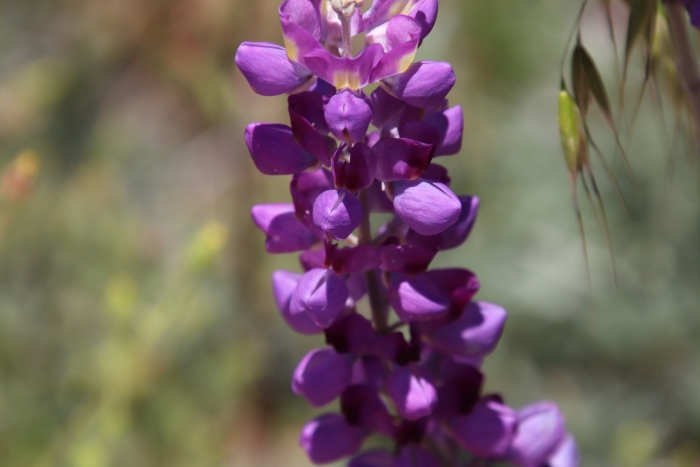Grape Soda Lupine
(Lupinus excubitus)
Grape Soda Lupine (Lupinus excubitus)
/
/

Millie Basden
CC BY 4.0
Image By:
Millie Basden
Recorded By:
Copyright:
CC BY 4.0
Copyright Notice:
Photo by: Millie Basden | License Type: CC BY 4.0 | License URL: http://creativecommons.org/licenses/by/4.0/ | Rights Holder: Millie Basden | Publisher: iNaturalist | Date Created: 2019-06-20T12:39:54-07:00 |











































































Estimated Native Range
Summary
Lupinus excubitus, commonly known as Grape Soda Lupine, is an evergreen subshrub or shrub native to the chaparral and open woodlands of California, Northwestern Mexico, and Nevada. It typically grows to a height of 3-5 feet (0.9-1.5 meters) with a similar spread. The plant’s gray-green foliage and fan-shaped leaves, which may cluster at the base, give it a distinctive appearance. Its raceme inflorescence features a tall stalk of rich purple flowers, each with a bright yellow spot, and blooms from late winter to early summer. The flowers are highly aromatic, with a scent reminiscent of grape soda. The fruit is a silky legume pod containing mottled brown seeds.
Grape Soda Lupine is valued for its drought tolerance and the striking color and fragrance of its flowers, making it a favorite for xeriscaping, native plant gardens, and naturalized areas. It is also used to attract pollinators such as bees and butterflies. This lupine prefers full sun exposure and thrives in well-drained soils, requiring minimal water once established. While generally low-maintenance, it can be susceptible to fungal diseases if conditions are too moist. It is important to note that Lupinus species can be toxic to livestock and pets if ingested.CC BY-SA 4.0
Grape Soda Lupine is valued for its drought tolerance and the striking color and fragrance of its flowers, making it a favorite for xeriscaping, native plant gardens, and naturalized areas. It is also used to attract pollinators such as bees and butterflies. This lupine prefers full sun exposure and thrives in well-drained soils, requiring minimal water once established. While generally low-maintenance, it can be susceptible to fungal diseases if conditions are too moist. It is important to note that Lupinus species can be toxic to livestock and pets if ingested.CC BY-SA 4.0
Plant Description
- Plant Type: Subshrub, Shrub
- Height: 2-3 feet
- Width: 3-5 feet
- Growth Rate: Rapid
- Flower Color: Purple
- Flowering Season: Spring, Fall, Summer
- Leaf Retention: Evergreen
Growth Requirements
- Sun: Full Sun
- Water: Low
- Drainage: Medium, Fast
Common Uses
Bee Garden, Bird Garden, Butterfly Garden, Deer Resistant, Drought Tolerant, Fragrant, Groundcover, Hummingbird Garden, Low Maintenance, Rabbit Resistant, Showy Flowers
Natural Habitat
Native to the chaparral and open woodlands of California, Northwestern Mexico, and Nevada
Other Names
Common Names: Inyo Bush Lupine
Scientific Names: , Lupinus excubitus, Lupinus excubitus subsp. excubitus,
GBIF Accepted Name: Lupinus excubitus M.E.Jones